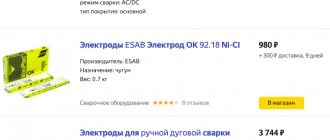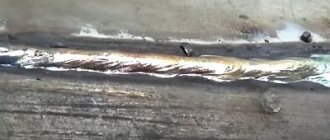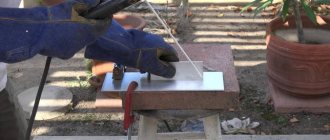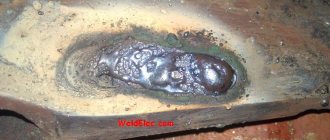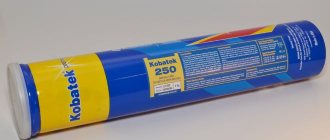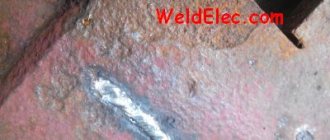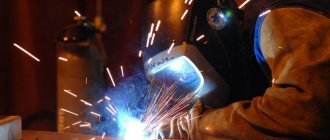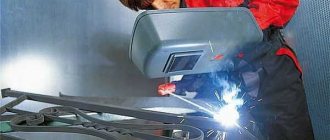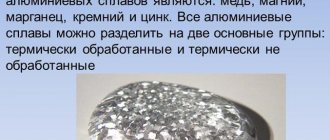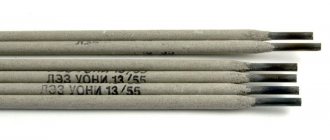An electrode calcination oven is used to dry and calcinate damp welding electrodes.
In addition, thermal cases are actively used to store previously calcined electrodes. The process of drying and calcining welding electrodes allows you to restore quality properties for guaranteed welder performance and the required weld performance. Today the market offers a wide range of such equipment, including electric furnaces and thermal cases for drying and calcining welding electrodes made in Russia, as well as thermos cases for storing previously calcined electrodes. This product can come in a wide variety of models and designs. Therefore, when choosing, you must carefully approach the issue of matching the price-quality ratio .
An electric furnace and a thermal cabinet for drying, calcining and storing electrodes for manual arc welding provide high quality indicators of electrodes during the welding process in particularly critical areas and objects. They are successfully used in the repair and manufacture of critical structures, as well as in welding various pipelines. The oven for calcining electrodes can be used as a drying chamber or for other necessary purposes. Drying installations can be either stationary or portable.
Why is it needed?
The coating of the electrodes absorbs moisture during storage . Technologically, it is a flux that affects the creation of a weld pool, the continuity of the seam and the cooling rate of the welded metal. Raw electrodes during welding are immediately visible:
- a lot of splashes are generated;
- the arc constantly goes out;
- The slag layer covers the seam unevenly and does not come off well.
Additionally, air bubbles form inside the seam, and some of the flux remains that does not float to the top. All these defects impair the strength and quality of the seam and make it unusable.
During mandatory calcination, moisture is removed from the electrodes . Furnaces that heat up to 400⁰C are usually stationary and located away from the welding stations. They are not sealed and cool down after switching off; moist air from outside enters them.
To keep consumables dry, welders use a pencil case for electrodes. It provides several operational advantages:
- easy to carry and always at hand;
- When transported over any distance, the electrodes remain dry;
- heating from the network and welder up to 110⁰C and above;
- eliminates re-calcination of unused materials.
When working on the road, such as repair crews, the welder does not know exactly how many electrodes he will need. It may be away from the oven for several days. Consumables are kept dry and heated by connecting a thermal case for electrodes to a 220V network and current from the welding machine.
Head of the Research Laboratory of Welding and Technologies at IISiSM Pavlogradsky Yu. S.: “The packaging of domestic electrodes always indicates the calcination time and temperature. But not all of them have a warning that they can only be heated 3 times. The composition of the coating is complex, multi-component. At high temperatures, some elements are destroyed, others enter into a chemical reaction with water and air components. The metal of the rod, depending on its composition, oxidizes or forms compounds with nitrogen. The quality of the electrodes and the seams they make is deteriorating.”
How does this oven work?
When electrical energy is supplied to the thermoelectric element, it heats up.
Heat is transferred to the inner chamber of the stove, in which the electrodes are processed; they are laid out in an even layer on special grids. Programmable oven models have a timer that automatically turns off the heating unit after a specified period of time.
Also, such models allow you to smoothly increase and decrease the temperature, without sudden jumps, which can lead to destruction of the coating layer on the electrode.
The time and temperature required for calcination are usually indicated by the manufacturer on the packaging with the electrodes. It usually takes about 2 hours. After storing electrodes in a warehouse for more than 3 months, they must be calcined. The same must be done if they are stored openly at the workplace for more than five calendar days.
Design and functionality
The case for calcining electrodes has a rectangular shape. The dimensions depend on the volume of the electrodes to be accommodated; for household devices it is approximately 150x170x600 mm. The pencil case consists of:
- frame;
- camera;
- a heating element;
- electrical insulation;
- thermal insulation;
- front cover for loading the camera;
- back cover and heating control unit;
- wires.
Before drying the calcined electrodes, they are placed in the chamber and tightly closed with a lid. Then, on the reverse side, the wires are connected to the power source. The heating element is turned on - a spiral wrapping around the outside of the chamber.
The chamber is first covered with insulation, only then the spiral is laid so that the current does not flow when touching the electrodes and the inner surface of the thermal canister.
The heating element raises the temperature inside the device to 110⁰C. This is enough for the moisture to evaporate. After 2 hours you can start working.
In a home workshop, with a small amount of welding work, they use covers for electrodes that have a plastic sealed housing . They retain the heat of hot objects placed inside and do not let air through. The coated rods cool for several hours, remaining hermetically sealed.
How to use such a stove?
It is necessary to distinguish between the drying and calcination processes:
- Drying is needed to remove excess moisture entering the electrodes from the surrounding air. It allows the use of low temperature conditions; its purpose is simply to remove moisture from the coating. At the end of the drying process, the percentage of humidity inside the electrode coating should be no more than 0.7%.
- Calcination is the process of completely removing moisture at temperatures up to 200 - 250 degrees Celsius. It is allowed to calcinate the electrodes no more than three times, then the coating on them begins to crumble and crumble. Such consumables are rejected and must be disposed of; welding work cannot be carried out with them.
When working with an electrode drying oven, you must follow basic safety rules:
- The device housing must be grounded or neutralized.
- Before starting work, make sure that the grounding wire is securely connected to the electric stove.
- During the process of drying or calcining the electrodes, do not touch the operating unit with your hands.
- It should be remembered that such thermal electrical equipment should be installed no closer than 10 centimeters from the wall.
Be sure to store electrodes in special containers:
Characteristics
When choosing thermal cases for electrodes, you should study their performance characteristics:
- maximum weight of loaded electrodes;
- device dimensions;
- power;
- heating temperature and the presence of a thermostat;
- weight when fully loaded;
- power supplies;
- presence of a convenient handle for transportation.
The thermopenal has various options for connecting to a power source:
- household current 220V;
- industrial three-phase 380V;
- permanent from the welding machine;
- combined connection.
Experts recommend a combined connection option . You just need to choose a combination of alternating and direct currents that match the available sources. For example, in a workshop there is 220V AC and DC current supplied by an inverter.
Exploitation
The instructions for proper operation of the equipment recommend taking out the electrodes while hot after calcination is completed and placing them inside the thermal case. Inside the chamber they will be inaccessible to moisture. They can be moved long distances and stored for a long time.
Before drying the welding electrodes, the device is installed on a special leg . Select the method of connecting to power. The plug is plugged into a power outlet. The two wires are connected to the cables going to the holder and clamp on the part.
The thermal pen is turned on in advance so that the camera has time to warm up. After about 30 minutes, you can open the front cover, take the electrode and start working. The pencil case should be kept closed to dry remaining materials.
Calcination and drying at home
Hobbyists are interested in how to dry electrodes at home if there are no special ovens. To do this, use conventional ovens in which pies are baked.
- Unpack the electrodes and take the amount needed for work.
- Place in the oven. It is advisable to use a lattice rather than a sheet.
- Turn on intense all-round heating.
- Set the temperature to more than 200⁰, which can be obtained in this oven model.
- Leave for 2 hours.
- Transfer to a thermal case.
The oven used is electric. When burning, a gas wick releases soot, moisture and other substances that settle on the coating and worsen its properties.
Drying electrodes at home can be done using a thermal pencil case. You need to take your passport and look at the maximum heating temperature. Then check the table on the electrode packaging. It depends on the material of the rod. Heat the chamber to maximum, after 2 hours switch to 110⁰. This temperature is enough to dry the electrodes.
A wire rated at 2 kW usually comes into the house from a pole. It may not withstand the load from the thermal pencil case.
Some craftsmen who do a lot of welding recommend simply placing the electrodes in a pack on a heating radiator. They claim that the coating completely dries within a few days. For simple structures that do not require particularly strong seams, this method may be suitable.
Proper heating is carried out at temperatures above 100⁰ so that the water evaporates . The amount of air should be small with a minimum moisture content.
Making a pencil case for electrodes with your own hands does not seem difficult. It looks like a small muffle furnace. Mineral wool or asbestos pipe is used as a heat insulator.
The chamber is made of a stainless steel sheet 2 mm thick. The top is covered with insulating fabric. Then the spiral is wound. A fire hose can be used as a material for the camera. It can withstand temperatures up to 200⁰C, is impervious to moisture and is made of electrically insulating fabric. The ends of the spiral are brought back and everything is covered with mineral wool.
The body can be made from a metal sheet, using the remains of a laminated roof and metal profiles. It is divided into 2 parts. The front one is large and accommodates a thermal chamber. There is a small space at the back for installing the switch and wiring. A handle is attached to the top for moving. A bracket is mounted in front - a stop.
The camera wrapped in mineral wool is placed in the housing and secured. The lid is double, inside there is a layer of heat insulation.
It is difficult to heat electrodes in a homemade chamber. It is used more like a dryer .
Drying ovens, calcination of electrodes, drying ovens
Products / Drying ovens, calcination of electrodes, drying ovensOvens for drying and calcination of electrodes are special-purpose drying cabinets designed for heat treatment and calcination of welding electrodes and other welding materials and fluxes. Furnaces for drying and calcining electrodes are manufactured in two versions: they can be either vertically or horizontally loaded. As a rule, drying and calcination of welding electrodes is carried out at a temperature not exceeding 400 C°. Furnaces for drying and calcining electrodes are a drying cabinet for welding electrodes equipped with an electronic or mechanical thermostat with which the heating temperature range is set, as well as the heating rate. Drying cabinets can be either with natural convection or can be equipped with additional fans. The set heating temperature in the drying cabinet is maintained automatically. Ovens for drying, calcining electrodes, drying cabinets SNOL SNOL - reliable equipment with a modern design and excellent recommendations. SNOL drying ovens SNOL have proven themselves to be excellent and are one of the most popular low-temperature ovens in their segment. Fast heating, stable temperature in the working chamber, plus convenient control and heating control make SNOL thermal equipment especially attractive. By making your choice in favor of thermal ovens and drying cabinets of the SNOL SNOL brand, you are making the right choice.
Oven for drying welding electrodes SNOL 75/350 and SNOL 75/550
Name
| SNOL 75/350 | SNOL 75/550 | |
| Price including VAT, rub. | 47 000 | 159 500 |
| power, kWt | 2,0/220 | 6/380 |
| Warm-up time, min. | 100 | 100 |
| Temperature range, C° | 50..350 | 50..550 |
| Error, temperature, C° | 1 | 1 |
| Temperature stability, C° | +/- 2 | +/- 2 |
| Chamber size, W*D*H, mm | 390*530*390 | 340*390*550 |
| Camera material | steel | stainless steel |
| Oven size, W*D*H, mm | 675*700*615 | 850*700*900 |
| Thermostat | electronic | electronic |
| Working volume, l. | 75 | 75 |
| Weight, kg. | 65 | 100 |
Furnaces for drying and calcination of welding electrodes of the EPSE series
This series of ovens is a worthy replacement for more expensive foreign-made models; drying ovens of the EPSE series are reliable and high-quality equipment made in Russia.
| Characteristics | EPSE 10/400 | EPSE 20/400 | EPSE 20/400.01M | EPSE 40/400 |
| Price, rub. VAT included | 3900 | 4900 | 6700 | 8800 |
| Voltage, V | 220 | 220 | 220 | 220 |
| power, kWt | 1,0 | 1,25 | 1,25 | 2,5 |
| T range, С° | 40~400 | 40~400 | 40~400 | 40~400 |
| Warm-up, min | 100 | 100 | 120 | 140 |
| Furnace dimensions, mm | 222*720*265 | 222*720*300 | 220*730*300 | 604*470*680 |
| Slave. camera, mm | 110*550*140 | 140*550*170 | 140*550*170 | 220*400*550 |
| Loading weight, kg | 10 | 20 | 20 | 40 |
| Furnace weight, kg | 15 | 18 | 18 | 40 |
| Control type | EM remote control | MP remote control | Without remote control | MP remote control |
| Characteristics | EPSE 50/400 | EPSE 40/400.01 | EPSE 50/400.01 | EPSP 140/400.01 |
| Price including VAT, rub. | 9500 | 12700 | 12990 | 23900 |
| Voltage, V | 220 | 220 | 220 | 380 |
| power, kWt | 3,0 | 3,0 | 3,0 | 6,0 |
| Temperature range, C° | 40..400 | 40..400 | 40..400 | 40..400 |
| Furnace dimensions, mm | 604*470*680 | 700*680*470 | 700*680*470 | 730*680*1000 |
| Slave. camera, mm | 220*400*550 | 400*550*280 | 400*550*280 | 400*550*635 |
| Loading, kg. | 50 | 40 | 50 | 140 |
| Furnace weight, kg | 40 | 45 | 45 | 100 |
| Control type | Without remote control | Remote control m/p | Remote control m/p | Remote control m/p |
Oven for drying welding flux EPSF 120/400
Furnaces for drying and calcining welding flux are electric furnaces designed for thermal preparation of fluxes for use in welding, directly in welding shops or at the site where welding work is carried out. The furnace for drying welding flux can hold up to 120 kg. working material, with a heating limit of up to + 400 C°. Vertical loading of flux into the work area is quite simple and convenient.
The EPSF 120-400 electric furnace is designed to operate in an explosion-proof room at an ambient temperature of 0..+50 C°. Climatic design of the EPSF electric furnace in accordance with GOST 15150-69. Service life of at least three years.
| Characteristic | Meaning |
| Price including VAT, rub. | 24 700 |
| Power, kW/V | 8,5/380 |
| Working t, max. С° | 400 |
| Thermostat setting range, C° | 100..400 |
| Warm-up time to max t. min. | 90 |
| Working chamber size, mm | 500*500*600 |
| Overall dimensions of the furnace, mm | 730*620*1360 |
| Maximum load, kg. | 120 |
| Weight, kg. | 65 |
Popular models
The main characteristics of the thermal pencil case are determined by the model designation. The first letters TP stand for thermal pencil case, PE stands for electric pencil case. The number behind them indicates the maximum load weight. The temperature that the equipment can reach is written through a fraction.
TP5/150
Hobbyists and welders in small workshops often use TP5/150. The chamber volume is enough to carry out repair work in the field and welding at home. A temperature of 150⁰ is suitable for drying electrodes stored for a long time . Connects to a 220V network and a welding machine.
The fully loaded weight of 10 kg makes it easy to carry in your hands. The reverse side of the rotary handle serves as stops in the working position.
TP-6/130
Powered by a welding machine. The body can be metal or fiberglass. Designed for stationary posts. It has good thermal insulation. The electrodes remain hot for a long time when the heating elements are turned off.
PE6-/150
The model has a round shape. Connects to the network and device. Often used by repair teams. The maximum weight of a loaded pencil case is 10 kg.
TP8/130
A chamber with 2 compartments is convenient for carrying out diverse work using materials of different brands. Easily transported from place to place.
TP10/150
Professional equipment with devices for automatically maintaining and adjusting temperature . It is mainly used in production with stationary welding stations. With the Thermopenal weighing 9 kg, it can be loaded with electrodes up to 10 kg.
As a last resort, you can place raw consumables in a thermal canister and dry them to working condition. Welders who make high-quality seams and weld critical structures calcine consumables in a furnace. The pencil case is used for storage and heating.
Manufacturers
One of the leading Russian manufacturers of furnaces for calcining electrodes is the TEN and K welding equipment plant, the city of Miass . Since 1998, the company has acquired significant experience in the production and sale of professional welding equipment. The company's products are in high demand. Electric furnaces have proven themselves well on the market; the main characteristics are improved thermal insulation and uniform heating of materials throughout the entire working space of the device. The units are equipped with visual control of temperature and time, which guarantees convenient operation. At the same time, the devices are actively used in various fields of industry.
The LINGAS company is a manufacturer of a wide range of specialized equipment, founded in 1992. A popular category are ovens for storing, drying and calcining electrodes. The products manufactured are developed at the level of the best foreign analogues and have all the necessary certificates. Qualified employees independently improve existing devices and develop new machines. New modern models are introduced into production every year. Equipment is supplied throughout Russia and the CIS countries.
Another large manufacturer of electrode furnaces is ZAO NOVEL . The history of the enterprise began in 1989, in 1995 the first batch of heating elements was produced. Over the next few years, the plant significantly increased its own product range. Today, customers are offered electrothermal, ventilation, welding and other professional equipment. Each product undergoes mandatory certification, so the products are characterized by high quality, convenience and ease of management. The sale of technical equipment is carried out through a dealer network covering all regions of Russia and the CIS countries. [ads-pc-2][ads-mob-2]
The production and commercial enterprise “Plazer” was founded in the mid-90s and has branches in three cities. The company specializes in the manufacture of welding equipment. One of the current categories of a wide range are furnaces for drying and calcining electrodes, as well as for storing already processed materials. The stoves are produced under the “ETP” marking. The organization produces products adapted to Russian operating conditions and using the latest technologies. The company also sells a wide range of welding materials, accessories and aids for professional work.
"Lincoln Electric" is one of the world's manufacturers of welding equipment and materials. The company was founded in 1895 and has sales offices in more than 160 countries. The company offers a wide range of technically modern equipment. The most popular products are furnaces for calcining electrodes. The design of these units is carefully thought out and developed using modern technologies. The devices have optimal characteristics and provide high-quality heat treatment. Electrode furnaces from the American concern can significantly improve operating efficiency.

